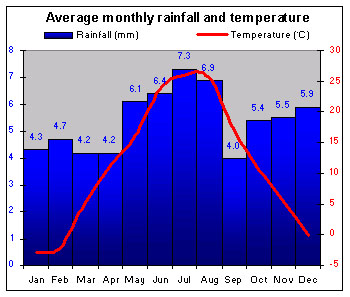COUNTRY INFORMATION |
Introduction |
Dominated for 900 years by neighboring Hungary, Slovakia spent much of the 20th century as the less developed half of communist Czechoslovakia. An independent democracy since 1993, Slovakia has struggled to create a modern market-led economy, but is now among the "second wave" of states conducting membership negotiations with the EU. |
|
Climate |
 |
Slovakia has a continental climate. Snowfalls are heavy in winter, while summers are moderately warm. |
|
People |
| Languages |
Slovak, Hungarian, Czech |
|
| URBAN/RURAL POPULATION DIVIDE |
|
|
|
Slovaks dominate society, but 11% of the population is Hungarian, and there is a significant Roma minority which faces discrimination. The Hungarian community, backed by Hungary, seeks protection for its language and culture. Tensions, however, have lessened since the inclusion in government in 1998 of the Hungarian Coalition Party. There were 300,000 Slovaks living in the Czech lands in 1993. Dual citizenship is now permitted. |
|
Economy |
| GNP (US$) |
19969
|
M |
GNP World rank |
66
|
|
| Inflation |
12 |
% |
Unemployment |
19 |
% |
|
StrengthsIncrease in manufacturing, especially in Bratislava and surrounding area. Recent progress in cutting budget deficits and restructuring public and private sector. Growth in exports to EU. Potential for tourism, particularly skiing in the Tatra Mountains. WeaknessesHigh foreign indebtedness. Dependence on foreign trade makes the economy vulnerable to global recession. Heavy industry has found some new markets in the West, but struggles with poor productivity. Slow to attract foreign investment until 2000. Much poorer eastern region. Growing unemployment. |
|
Politics |
| Lower house |
Last election |
1998 |
Next election |
2002 |
| Upper house |
Last election |
Not applicable |
Next election |
Not applicable |
|
The move which led to the separation of the two halves of the former Czechoslovakia in 1993 gathered momentum when Slovak leader Vladimir Meciar was tempted by independence as a way of enhancing his power base. The populist Meciar dominated Slovak politics until 1998, but clashed repeatedly with President Michal Kovac, both of them members of the HZDS. A broad coalition led by center-right politician Mikulas Dzurinda won power in elections in September 1998. Slovakia's first direct presidential election in May 1999 was won by the pro-Western Rudolf Schuster, frustrating Meciar's bid for this office. The Hungarian minority has its own parties, one of which joined Dzurinda's ruling coalition, whereas the Roma have no official representation. |
|
Resources |
| Minerals |
Coal, lignite, gas, oil, antimony, copper, iron, mercury, zinc |
|
| Oil reserves (barrels) |
7.5m barrels |
Oil production (barrels/day) |
1203 b/d |
|
44% of electricity was nuclear-generated, even before the Mochovce nuclear plant began operations in 1998. |
|
Health |
| Life expectancy |
73 |
Life expect. World rank |
51 |
| Population per doctor |
286 |
Infant mortality (per 1000 births) |
8 |
|
|
|
| Principal causes of death |
Cancers, heart and cerebrovascular diseases, accidents |
|
Rising demand and costs are straining the health service severely. Restoring viability is now a government priority. |
|
Education |
| Literacy |
99 |
% |
Expend. % GNP |
4 |
%
|
|
| PERCENTAGE OF POPULATION IN FULL TIME EDUCATION |
|
| Primary |
100 |
% |
Secondary |
86 |
% |
Tertiary |
27 |
% |
|
Schooling now draws on pre-1939 Slovak traditions but it is not adequately resourced, especially in rural areas. There is a modern university in Bratislava. |
|
Wealth |
| Cars |
229 |
per 1,000 population |
| Telephones |
314 |
per 1,000 population |
| Televisions |
407 |
per 1,000 population |
|
A new elite is increasing demand for Western goods. Rural workers, Roma, and those living in the east are the poorest.
|
History |
Once part of the Austro-Hungarian Empire, Slovakia and the Czech Lands formed the Republic of Czechoslovakia in 1918. - 1939–1945 Separate Slovak state under pro-Nazi Jozef Tiso.
- 1945 Czechoslovak state restored.
- 1947 Communists seize power.
- 1968 "Prague Spring" ended by Warsaw pact invasion.
- 1989 "Velvet Revolution."
- 1990 Free multiparty elections.
- 1993 1st January, separate Slovak and Czech states established.
- 1994 HZDS election victory.
- 1998 Broad-based coalition wins general election.
- 1999 Rudolf Schuster defeats Meciar in direct presidential poll.
- 2000 EU negotiations begin.
|
|